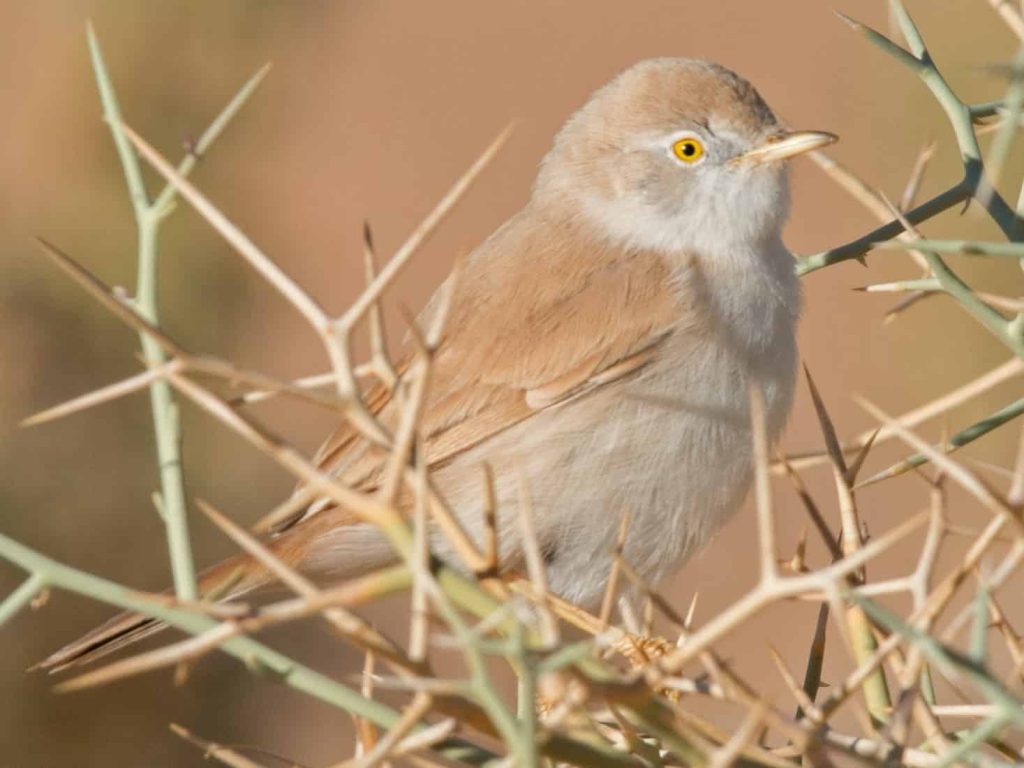The African desert warbler or (curruca deserti) is a small bird species that are found in the Sahara and Sahel regions in North Africa, he lives in countries such as Morocco, Algeria, Libia, Mauritania, Mali, Niger, Tunisia, and Senegal. This bird prefers to live in arid and semi-arid environments, It’s typically found in open desert habitats, including sand dunes, gravel plains, and rocky plateaus.
In this article, I will discover for you the most important points should know about this bird, Physical adaptations, reeding, and reproduction, Vocalizations, Threats and conservation, Research, and study of the African desert warbler, Importance to the ecosystem, and Behaviors…

How the African Desert Warbler Survives in the Harsh Desert Environment:
There are many factors that make desert warbler survives in the desert which is almost non-existent in water and food, let’s see some of these important factors:
Morphological Adaptations:
the first thing that makes this bird endures the harsh environment is its slender body as it makes it doesn’t need to consume much food which makes it move from one place to another easily, and the second thing is its Long Legs and tail, which help it to move on the sand dunes easily without his feet getting immersed in the sand addition to his tail that help it to stays balance.
thirdly, its plumage Coloration makes this bird in harmony with sand and this is thanks to its color that looks like dunes, and this helps them from large birds like the pharaoh eagle owl, other types of eagles, and humans as well.
fourthly, because of its protective Eye adaptations, desert warbler has a nictitating membrane that is a translucent third eyelid that can be drawn across the eye to protect it from blowing sand. this membrane also protects his eyes from Bright sunlight and dry eyes, which keeps his eyes always moist.
Water Conservation:
water conversation; African Desert warbler has a very high water conversation, and this is due to their kidneys as they have a highly concentrated urine production, his kidneys filter the water that he drinks and the waste and urine are only what the body does not need without excreting even a little pure water, to save more water in his body.
also, this bird when breathes, its noise doesn’t keep the dry air effect to the humidity in his body, because when he breathes out, the nasal passages help to trap moisture in the exhaled air.
nocturnal behavior: he has also another feature that is nocturnal behavior, To avoid the intense heat and high evaporation rates during the day, the African Desert Warbler is primarily active during the cooler hours of the early morning and late evening. By minimizing activity during the hottest times, the bird reduces water loss through respiratory and evaporative processes.
Obtaining water from food: this bird and the most popular of other desert species choose some plants that have water inside them, In addition to Insects and spiders which is also an essential source of some moisture that keeps them alive.
Where Does The African desert warbler Build Nests:
This bird doesn’t build Nests on the trees or the holes, he builds nests on form cups typically on the ground under a tree or a rock and he does that for the shadow to protect himself from the hot temperature in addition to the camouflage.
desert warblers typically prefer to live far away and in places that are empty of humans, he is a quiet bird and loves to live in nature far away from residential complexes, because he doesn’t like the hype and the cars’ fumes.
Breeding Season and Timing:
the breeding season for the African Desert Warbler starts in March or April and extends through July or August, this bird chooses this time because these months are the best from the side of the weather when it’s warm, and the availability of the food in these months is more than others.
also, they choose this period because this time is the most rainfall patterns and the availability of suitable nesting sites.
during the breeding time, the males compete for the female, who will impress her by dancing and singing, and after the female choose someone of the males, they go to the nest, The female lays a clutch of 3 to 5 eggs, which she incubates for about 12 to 14 days.
Once the eggs hatch, both the male and female in the Little Sparrow care for and feed, when the male sets with the little sparrow, the female goes looking for food and water and when she arrives comes the turn of the male to look for it and the female set with him. the little sparrow leaves the nest after 9 to 12 days to learn how to fly In addition to having the responsibility to live in this harsh and hard areas.
By the way, It’s important to note that the breeding time for desert warbler change due to the area and other factors like weather, feeding, rain, etc…
Threats Facing African Desert Warbler:
there are many threats and factors that face this bird in this harsh environment and arid areas, let’s see the important threats:
Habitat loss:
As we know the main reason for extinction of the most animals and birds is human’s development, and these birds also threaten to extinction because of humans firstly and the environment secondly. Desertification, human development, expansion of agricultural activities, and infrastructure projects can all lead to the destruction and fragmentation of the bird habitat.
Climate change:
Desert warble like other desert species face climate changes such as habitat Alteration as we know, this bird found in arid and semi-arid areas in North Africa that known low rainfall, extreme temperatures, and sparse vegetation. but despite all this, climate change has greatly affected this bird disrupting the delicate balance on which the survival of these warblers depends.
Illegal Trapping and Trade:
It’s a pity to see some people sell and buy like these rare and endangered birds, as I live in Merzouga that located in southeast of Morocco and I see sometimes some people try to hunt like these birds such as African desert warbler, Desert Sparrow, Egyptian Nightjar, Greater Hoopoe lark and other Desert birds.
And they do that because they use their feathers in some works, and other people do that because of the tempting offers offered to them by foreigners

